Star Wars, the shopping
Let the Cookie Win: New Star Wars Jars

The fact that there has never been an official Darth Vader ceramic cookie jar produced in the last 28 years has confounded fans, collectors, and snackers for an entire generation.
R2-D2 and C-3PO were the first to reach this hallowed height of housewares, upsized from a smaller set of clay banks made by Roman Ceramics in 1978. Darth Vader was the third in this series of three banks, but strangely didn't make the trip up along with the droids.
Flash forward to the mid-90s, when Star Jars began a series of Star Wars ceramic cookie jars that included Vader in a planned extension of the line. Unfortunately, plans crumbled, and any hope for a Darth Vader cookie jar was scattered like crumbs to the wind. EDITOR'S NOTE: ALL THESE COOKIE JOKES ARE JUST ICING ON THE CAKE, AIN'T THEY? (SORRY).

Now, fans will finally be getting their heavily glazed black clay Vader jar courtesy of Cards Inc. in England, who is releasing an all new line of Star Wars cookie jars this year. Vader is among the first in a series of 14 different jars planned for the line, which also includes cookie jar mainstays R2-D2 and C-3PO.

EDITOR'S NOTE: R2D2 IS STILL THE MOST PERFECTLY DESIGNED TO BE A CANISTER. THE REST LOOK COOL, BUT R2 PRACTICALLY BEGS TO BE A RECEPTICLE.
Collectors who own the early Roman Ceramics R2-D2 will be pleased to discover that the Cards Inc. version poses the famous astromech on three legs, a cookie jar first for R2.
Also of note is that Darth Vader and Yoda, in addition to being released in the traditional cookie jar bust form, will also be offered as full figures -- another Star Wars first (unless you count the earlier R2).
The 12 busts in the series measure approximately 13"-14" in height and 12" in width, and will come in a full color display box (unlike the Roman versions, which arrived in a plain blue on white box).

Fans can also look forward to a Wookiee cookie jar, of course!
Here's a list of what to expect from this exciting line from Cards Inc.
Darth Vader Bust
Clone Trooper Bust
Yoda Bust
General Grievous Bust
C-3PO Bust (Gold Plated)
Stormtrooper Bust
Clone Trooper Bust
Clone Trooper (Shock Trooper) Bust Variant
R2-D2
Chewbacca Bust
Boba Fett Bust
Yoda Full Standing
Darth Vader Full Standing
Death Star
StarWarsShop.com has already got a couple of these up for pre-order, so be sure to head on over to check them out now!
Make A Pillow Fit for Yoda
EDITOR'S NOTE: I'M ALREADY ON MY SECOND PILLOW!!! (AND IF YOU KNEW HOW CLOSE I CAME TO FAILING HOME-EC IN JR. HIGH, YOU WOULD BE ESPECIALLY AMAZED BY THIS!)
The action never seems to stop in Star Wars: Episode III Revenge of the Sith, so it's hard to pick the best lightsaber duel.
Now you can pay tribute to Star Wars characters whether you're rooting for the Jedi or the Sith, by making your very own pillow using Revenge of the Sith patterned fabrics from Springs Creative Products Group.
Follow the simple instructions below to make a fun pillow for your room or lounging area.
What You Need for the Episode III Pillow:
Revenge of the Sith patterned fabric EDITOR'S NOTE: LIKE, DUH.
A pillow form or an old pillow you want to cover
thread
sewing needle
pushpins
measuring tape
scissors
How to Make an Episode III Pillow:
1. Place the fabric over the pillow to get an idea of how you want the fabric look. Take measurements of the fabric and cut the piece into either two large square pieces, or one long rectangle. Or if you aren't too picky with making the pillow exact, you can have an adult use pushpins to secure the fabric around the pillow. Then take the scissors and cut the fabric.
2. Once the fabric is cut, turn the fabric inside out and use pushpins to secure the two pieces of fabric together. The inside of the fabric should be facing out on both sides. If you cut a large rectangle instead of two squares, simply fold the fabric over once and pin the sides of the fabric. Be sure to leave on opening on one side (so you can stuff the pillow in later).
3. Have an adult EDITOR'S NOTE: I DID THIS MYSELF, SINCE I DON'T KNOW ANY ADULTS. (AHEM. YOU ARE READING THIS, SO LIKELY YOU DON'T EITHER).sew the sides together at the edges where you placed the pushpins.
4. When you are done sewing, go ahead and take the pins out of the fabric. Then turn the sewn fabric back out so the colored part of the fabric is now showing. Put the pillow form inside the fabric.
5. Pin the remaining open side and sew it shut. Take the pins out and there you have a pillow worthy to be placed in any Jedi Council.
For more Revenge of the Sith crafts ideas using special fabric like this be sure to visit the Springs Creative Products Group website. EDITOR'S NOTE: CHECK OUT THE COOL FABRIC, BELOW!
Sew Be It, Jedi: New Star Wars Fabrics
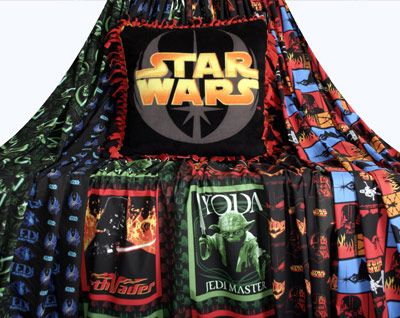
For crafty Jedi and sew-worthy Sith, Springs Creative Products Group introduces its new line of fabrics just in time to celebrate Revenge of the Sith.
Now available in major craft stores everywhere, the Revenge of the Sith fabric collection includes designs representing both the Jedi and Sith on cotton wallhanging panels, pillow panels, and all-over character and icon prints.
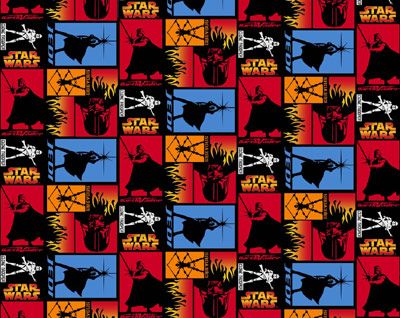
EDITOR'S NOTE: I HAVEN'T FOUND THIS GROOVY PATTERN YET. I'M WORKING WITH THE YODA/DARTH PANELLED FABRIC, BELOW.
In addition, there are three fleece and cotton flannel designs which include a decorative throw and two patterned prints.
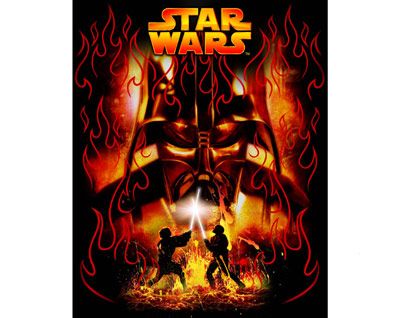
"Being the resident Star Wars fan, I worked with stylist John Burling on what elements I thought would be interesting to include in the Star Wars collection," Springs Creative Products Group Marketing Webmaster David Huntley says. "So I was able to provide my input on what I already knew was going to be cool from Episode III and have those elements in the collection. These fabrics capture the fun and thrill of the movie in print, while giving fans the opportunity to take home part of the movie and live with some of the excitement." EDITOR'S NOTE: AND LIVE WITH IT WE SHALL!!
The Vader's Revenge pattern displays a black background with fiery images including Darth Vader's mask, eyes, the various logos.
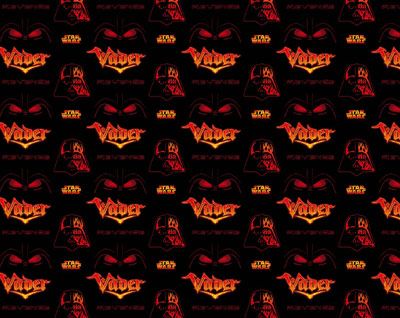
The wallhanging features the legendary lightsaber duel between Anakin Skywalker and Obi-Wan Kenobi. One patch features graphic images of Darth Vader, while another patch has a collage of graphic images of various Star Wars characters.
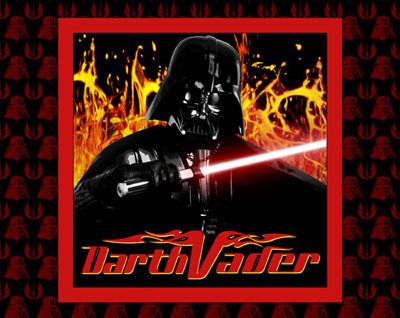

Customers can use the fabrics to decorate rooms with curtains, bedspreads, patchwork quilts and pillows, as well as create unusual gifts and home accessories such as wallhangings, tote bags, covered desk accessories and school book covers.

"We have seen a fan make a 16-inch high-density foam cube covered in pillow squares with Yoda and Vader on alternating sides," EDITOR'S NOTE: OOO..THAT'S EXACTLY WHAT I'VE MADE! Huntley says. "Ive also seen a bean bag chair made in one of the all-over fleece prints."
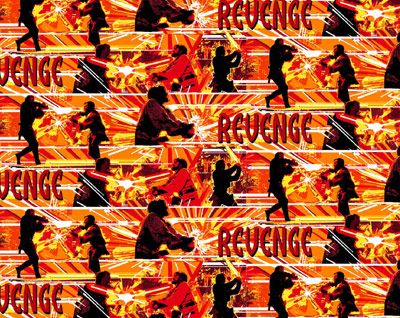
For an easy kids' project or the novice crafter, Huntley suggests customers look for the fleece pillow kit that requires no sewing. The 27" square floor pillow features the Star Wars logo and the Jedi symbol. EDITOR'S NOTE: OOO...THIS LOOKS GROOVY!

"We look forward to seeing how these fabrics are used by the fans, so if anyone has a unique idea drop me an email with a photo and we'll feature it on our website," Huntley says. "And we will also be producing fabric inspired by the original trilogy, so be sure to look for Luke, Han, Leia, Vader and Chewbacca in fabric by the yard late this year." EDITOR'S NOTE: OH I'D WISH THEY'D HURRY; I'M GOING TO HAVE TO BE COMPLETELY RETRAINED IN THIS NEW PILLOW SKILL IF THEY WAIT TOO LONG!
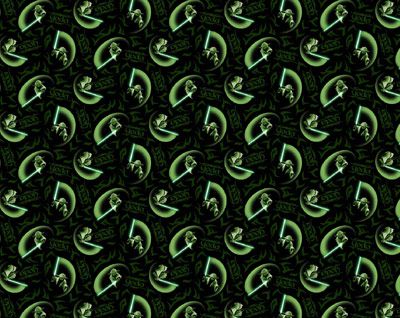
Major fabric chains in the U.S., with nearly 5,000 locations, each have a selection of all Star Wars fabric designs. Retailers include Wal-mart, Joann Fabrics and Crafts, Hancock Fabrics and Hobby Lobby.
Hancock Fabrics also sells Star Wars fabric online here.
http://www.hancockfabrics.com/index.jsp
http://www.springscreativeproductsgroup.com/starwars.htm
COMICS FROM A GALAXY FAR, FAR AWAY: DARK HORSE'S
STAR WARS COMICS
by Benjamin Ong Pang Kean
With the release of the highly-anticipated Star Wars Episode III: The Revenge of the Sith, the final chapter of the Prequel Trilogy that will see how Anakin Skywalker falls from grace and becomes one of the most iconic villains in cinema history, Darth Vader.
While Star Wars fans have looked forward to the big screen version of the final installment of the Prequel Trilogy, fans (old and new) of Dark Horse’s Star Wars comics will continue to be treated to loads of Star Wars goodness, set in the eras’ past, present and future.
However, not everything will be staying as it was.
We’ve got a download of the upcoming changes and new directions.
First off, one of the major highlights fans of Dark Horse’s Star Wars comics line will see is July’s Star Wars: The Comics Companion TPB by writers Ryder Windham and Daniel Wallace and artist Tsuneo Sanda. The Comics Companion is the definitive guide to Star Wars comics, complete with in-depth coverage from the first Star Wars comics all the way through Episode III, including the movie tie-in minis, Obsession and General Grievous.
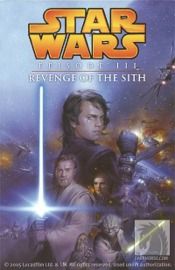
Basically, it’s a comprehensive guide to Dark Horse’s Star Wars comics, including the Marvel reprint volumes, published over the past fifteen years,” Wallace told Newsarama. We’ll have more from the Companion team at a later date, but as for Wallace, his thoughts are for the future of the franchise.
“Having seen Episode III at a press screening, I can confidently say that the film saga has gone out with a bang, on a thematically satisfying note that hits all the big Star Wars action beats. “LucasFilm plans to continue the saga in television, and given the well-produced - and underrated, in my opinion - Young Indiana Jones Chronicles, I have high hopes for this series. The TV series will also provide a high-profile hook to continue spin-off adventures in novels, comics, and gaming. “Beyond that, the future is less clear,” Wallace added. “I know only that Star Wars is unlikely to ever go away. The film version of the Wizard of Oz has been a perennial favorite since 1939 (and the books go back more than a hundred years) and shows no sign of ever going away. We'll still be watching the Wizard of Oz fifty years from now. It's no stretch at all to say that we'll be watching Star Wars one hundred years from now, or even longer.”EDITOR'S NOTE : FROM HIS MOUTH TO GOD'S (LUCAS) EARS.
On April 23, creator George Lucas, in his first convention appearance in 18 years, announced that he has green-lighted two Star Wars television series spin-off at the Star Wars Celebration III in Indianapolis, much to the delight of fans the world over.
The first is an animated 3-D, 30-minute series based on Cartoon Network’s popular Star Wars: Clone Wars shorts, while a live-action series that will focus on the early days of the Rebellion and will feature stories taking place between Episode III: Revenge of the Sith and the original 1977 Star Wars movie, A New Hope.
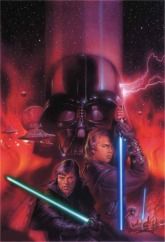
“ It was also reported at the Convention, though not officially confirmed by Dark Horse at that time, that there will be a three-issue Rogue Squadron mini-series by writer Haden Blackman (Star Wars: Republic #51-53 and Jango Fett: Open Seasons).
Randy Stradley, Dark Horse’s Vice-President of Publishing, later posted on the DH boards that “The new series is entitled X-Wing: Rogue Leader and will star Luke [Skywalker] and Wedge [Antilles], along with the rest of the Rogues.”EDITOR'S NOTE: ROGUE SQUADRON ROCKS!!!
On the fate of the monthly Republic series after ROTS, Stradley posted on the FAQ thread that “The last arc set before ROTS is the “Siege of Saluecami” (Republic #74-77).
Next will be a two-part arc set immediately after ROTS, by Welles Hartley and Doug Wheatley.
Then, a one-shot written by John Ostrander, illustrated by Luke Ross.
The final arc will be Republic #81-83, which will be a John Ostrander and Jan Duursema collaboration. ”It is too early to reveal what Dark Horse has planned for after this.”
2005 marks the 14th year of the publisher’s relationship with LucasFilm, which has seen it expand the Star Wars Universe in virtually all eras, from the original trilogy, to the prequels, and into the distant past.
Together with the LucasFilm-licensed videogames and novels, the Dark Horse comics have fleshed out the initial vision of George Lucas into a sprawling universe. Over the years, many of Dark Horse’s projects have settled into roles as fan favorites among the canon.
One of its most popular was Star Wars: Dark Empire, set six years after Return of the Jedi, which helped to kick off the publisher’s era of Star Wars comics. Two sequel comic book series, Dark Empire II and Empire’s End followed.

The Crimson Empire series took a look at the Emperor’s Red Royal Guards and introduced Kir Kanos and Carnor Jax to the Star Wars mythos in two six-issue limited series, Crimson Empire and Crimson Empire II: Council of Blood by co-writers Mike Richardson and Randy Stradley with art by Paul Gulacy and P. Craig Russell.
The publisher has also adapted Timothy Zahn’s Thrawn Trilogy of novels in three six-issue limited series, Heir to the Empire, Dark Force Rising and The Last Command.
One of the most innovative series of Star Wars comics published by Dark Horse was Tales of the Jedi, a series that took place thousands of years before the Rebellion’s struggle against the Empire and introduced Ulic Qel-Droma, Nomi Sunrider, Exar Kun, Naga Sadow and Gav and Jori Daragon to the Expanded Universe in the various Tales of the Jedi series of limited series, The Freedon Nadd Uprising, Dark Lords of the Sith, The Sith War, The Golden Age of the Sith, The Fall of the Sith Empire and Redemption.
Dark Horse has also pleased classic Star Wars fans with the reprints of all 107 (non-canonical) issues of the original Marvel comics, including the three Annuals, in its seven-volume Classic Star Wars: A Long Time Ago…. The collection included stories by fan-favorite creators such as Archie Goodwin, Roy Thomas, Chris Claremont, Howard Chaykin, Carmine Infantino, Walt Simonson and others.
The monthly Star Wars series, started in 1998, was re-titled Star Wars: Republic from issue #46, following the events in Episode II where the Clone Wars finally kicked off.
Republic introduced Asajj Ventress and Durge, two villains that were also featured in the Clone Wars micro-series.While Republic focused on the prequel trilogy, Dark Horse created Empire, a new monthly series in 2002 that featured the classic trilogy characters.
As for the fate of Empire post-ROTS, Jeremy Barlow, Associate Editor, posted that “we're still doing the five-part [Janek] Sunber arc in Empire. The series "ending at the end of the year" doesn't mean that it's ending at the end of the year.”
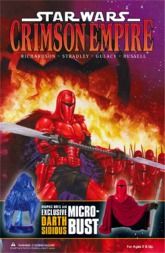
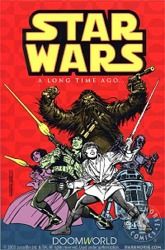
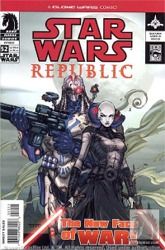
Star Wars Tales, a quarterly anthology that originally allowed some of the industry’s best and brightest creators such as Andy Diggle, Garth Ennis, Peter David, Ron Marz, Tony Millionaire, Peter Bagge, James Kolchaka, Gilbert Hernandez, Rob Williams and others to tell their own short stories without limitations of continuity and set outside of the established Expanded Universe, underwent a radical retooling in October of last year.
Since then, Tales became more of a companion to the other two Star Wars monthlies and carried stories that were filled with longer, in-continuity adventures that span every Star Wars era, from the Old Republic, the Prequel era, the Classic Trilogy to the New Jedi Order. EDITOR'S NOTE: THERE'S BEEN SOME WHINING AMONG THE COMICS FANS ABOUT CHANGING 'TALES' TO BE MORE CONVENTIONAL AND IN-CONTINUITY. BUT THE SWITCH HAS BEEN EXCELLENT IN MY OPINION. THERE'VE BEEN SOME REALLY COOL ADDITIONS TO THE TIMELINE WITHIN THE TALES IMPRIMITEUR.
Most notably, Kyle Katarn, star of the hit video game Jedi Outcast, went toe-to-toe with the vile Yuuzhan Vong, in a tale by Nathan P. Butler and James Raiz in #21.
One of the three stories in #22 tied in to the LucasArts video game, Republic Commando and issue #23 carried a prequel to the popular Knights of the Old Republic video game.
However, according to Barlow, Tales is ending with issue #24. EDITOR'S NOTE: BUMMER. (IT'S CAUSE I GAVE IT A COMPLIMENT, RIGHT?)
“We needed to make room in our publishing schedule for the big 2006 re-launch, and ending Tales here completes the sixth TPB volume, which made sense. This last year's been a helluva run, and I couldn't be more proud of the work we all produced. ”Though Tales will be ending, I'll be bringing the same sensibilities (and many of the same creators) into the 2006 plans, and when all is revealed you'll find the niche that Tales is currently filling will all but disappear. And that's a good thing.”“From the way things are shaping up, Republic, Empire, and Tales will go out on high notes,” Stradley said in another post. “… Also, before the end of either of the ongoing series, we will provide you with a peek at what is to come in plenty of time for you to go mad with anticipation. The news we have coming in the months ahead will, I'm sure, delight many of you… But please allow us to reveal our plans on our own schedule. Nothing is ready to show yet, and spilling the beans now runs the risk of too many of you having your anticipation peak too early, and then becoming complacent about what is to come. ”Better that you think of this as similar to the time when you knew the Prequel films were coming, but you did not yet know what they would be about exactly. I just hope that our Young Anakin series won't be as disappointing as some of you found TPM to be... (I'm kidding! There is no Young Anakin series. Again, relax.) ”Please anticipate, feel free to speculate, but try not to mourn (or gloat) too much.
And remember, just because Republic and Empire might be ending, it doesn't mean that Dark Horse will abandon those time periods. As for Tales, we gave it a good run, and put our best efforts into it, and you can't blame Dave Land, or anyone else for its demise. Tales was never as successful as our other series (the same is true of most anthologies), and we finally decided that our resources were better focused elsewhere. Again, we think you'll be pleased with what is in the works. We certainly hope you will be. But until the future is revealed, I'd advise against treating any of the existing series as if they're already dead. If you do, you'll miss a bunch of good stuff!”

He later clarified that DH’s revamp has nothing to do with the release of Episode III.
“It has nothing to do with the film's release, and everything to do with the fact that 2006 is Dark Horse's twentieth anniversary.”Barlow later revealed that one of the new series will be written by John Jackson Miller (Iron Man, Crimson Dynamo) with art by regular Star Wars artist Brian Ching.Miller’s first Star Wars story will be July’s Empire #35, also penciled by Ching.
As mentioned, John Ostrander is working on issue #80 of Republic, currently scheduled for August. Joining Ostrander will be artist Luke Ross and it “will tie back to the three issue arc that opened the Republic run,” Stradley posted.
Ostrander later added that “SWR 80 will be essentially self contained. Everything you need to enjoy that story will be in that story. If you did read the earlier arc, some of the characters will be more familiar. But Sagoro Auten has a supporting role in the current “Saluecami” arc as well. But I'm not assuming everyone has read or remembers (let alone remembers fondly the “Honor and Duty” arc previously done.”
It seems that Tales artist Brandon Badeaux is also working on a Star Wars project. “I've read one of the pitches that isn't the one I'm working on but from the two new stories I know about, the new series are going to be better than what we were doing before and it seems like our reigns are going to get to come off,” he posted. And judging from the other title names I'm sure you'll all be thrilled with what they'll come out with. I had a ton of fun with this year’s run on Tales but am more enthusiastic about the new project. ”Trust me, 2006 should be an awesome year for SW comics.” EDITOR'S NOTE: OK OK. WE'LL TRUST YOU. BUT JUST THIS ONCE.
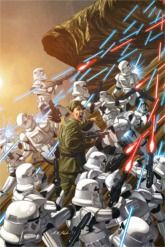
Another project scheduled for later in the year, in September, is Star Wars: Clone Wars Adventures Volume 4 by writers Haden Blackman, Ryan Kafman, Justin Lambros with art by Rick Lacy and the Fillbach Brothers. The fourth volume will include four tales of hyperkinetic Clone Wars action.
According to the solicitation, “As the Clone Wars burn across the galaxy and the true intentions of the Sith are revealed, the true heroes of the conflict emerge. Chewbacca leads the Wookiees against the Republic invaders on the jungle world of Kashyyyk, R2-D2 and C-3PO uncover a plot to assassinate Padmé, an orphaned refugee witnesses the rough life of a Clone Trooper firsthand, and Anakin Skywalker fights alongside a young Jedi who will play a part in his descent into the Dark Side.”
According to Barlow, a new Jedi character, Serra Keto, will appear in Vol. 4. Keto’s one of the new characters introduced in the Star Wars Episode III video game. In the game, she was one of legendary Jedi Master Cin Drallig’s students. For the record, Barlow wrote the dialogue for the game.So, while the films may just be ending, Dark Horse’s adventures in the Star Wars universe aren’t even close. In the eyes of the publisher, there are still countless stories to be told in that galaxy far, far away. EDITOR'S NOTE: I WAS REALLY ENJOYING THE CLONE WARS STORIES, AND SEEING THE BATTLES FROM THE CLONE-EYES-VIEW. NOW THAT WE KNOW THE CLONE ROLE IN THE DECIMATION OF THE JEDI, IT IS HARD TO HANG OUT WITH THEM. NOT SURE THEY CAN BE SYMPATHETIC TO ME ANY MORE.
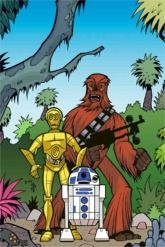
AN INTERVIEW WITH ROTS COMIC BOOK ARTIST
DOUG WHEATLEY
A few months ago, a co-worker showed me a newspaper clipping she thought I might be interested in reading. It was about a fellow she bowled with; and because she knows I am the local Star Wars geek, she thought I might like to meet him. That man is Douglas Wheatley, the artist who drew the comic adaptation of Revenge of the Sith! Of course I had to take her up on her offer.
At the end of April, Doug and I met and he has kindly answered some of my questions and also has given us a sneak peek at his next Star Wars project.
Maureen: First, Doug, let me thank you for taking the time out of your busy schedule to meet with me and answer my questions. Let's start at the beginning. I, like millions of other fans, remember seeing Star Wars in the theatre for the first time in 1977. What was it about Star Wars that first grabbed your attention?
Doug: Darth Vader, I saw "A New Hope" when I was 8 years old. Darth Vader came on stage, glowing lightsaber in hand to introduce the film. I flipped out, this was the most fantastic thing I have ever seen! Then I saw the movie, I was hooked.
Maureen: Would you have ever, in your wildest dreams, thought you would one day be working on an actual piece of Star Wars history?
Doug: Never in a million years! The whole experience is still sinking in. In a strange and wonderful way I have come full circle with my childhood. I played with the toys, read the comics, saw the rest of the films etc. The Star Wars mythology has had a huge impact on my life, both in the past and the present.
Maureen: Did you ever draw Star Wars characters when you were young? (and if so, did you save them?) I think if you did, that would a great thing to see now.
Doug: I began drawing the Star Wars characters when I was about 10 years old. I spent a great deal of time drawing space battles, Darth Vader, R2-D2 and other characters. It dominated my imagination as a child. I think my mother still has a sketch book.
Maureen: What is your background in fine art (for example, your formal training beyond high school)?
Doug: When it comes to drawing, I am mostly self taught. When I decided to pursue a career in comics, I sought out a comic artist in my city by the name of George Freeman. He taught me much of what I needed to know to break into the comics field. I've met other artists since then, Chris Quilliams, Nick Burns, Chris Chuckry. They all have had an impact on my growth as a practicing artist.
Maureen: How do you get yourself prepared to work on such a daunting task? I like to draw or paint for fun, but I have to be in the mood to do a good job. I have always admired people who can create for a living; being able to crank out wonderful creations by a deadline!
Doug: It can be tough to draw or paint on demand. Every once in a while you will run into a creative block. I have found over the years that I must draw through these creative "blocks" to overcome them. In the past, when I sat down at the desk to draw, and nothing seemed to be turning out well I would shut down, and I would sometimes quit for the day. Now when this happens, I will draw through it, work until I'm inspired again, work until I feel that the drawing is coming together. I do this by focusing my attention on something in the drawing like the eyes of the character, or clouds in the sky. It takes about an hour, hour and a half to "break" through these creative blocks.
Maureen: Have you always wanted to draw in the animated style, or do you delve into other artistic mediums?
Doug: I don't have much time lately to explore other mediums. I love to paint, before I broke into comics I studied the masters, Michelangelo, Alphonse Mucha, N.C Wyeth etc. I also have a interest in sculpting.
Maureen: I know you have been involved in other projects; can you tell us which ones you are most proud of, or which ones you considered “stepping stones” in the evolution of your personal drawing style?
Doug: Okay, here goes, I think the most significant books I've done in the past are, "Magic The Gathering-The Elder Dragons, for Acclaim comics. This is the first book I worked on where we did not use an inker. Aliens: Apocalypse - The Destroying Angels for Darkhorse comics would be the next stepping stone, and then Episode III at Darkhorse comics would be the latest stepping stone. The books I am most proud of are, Aliens: Apocalypse - The Destroying Angels, Star Wars Darklighter, StarWars Episode III.
Maureen: When working on Revenge of the Sith, how did you get your reference material? (ie. would you “storyboard” with the writers or were you allowed to view images from the movie?)
Doug: In the beginning, we went out to the Ranch to meet with Sue Rostoni (Managing Editor at Lucas Licensing) and read the script which was a complete thrill! Soon after I returned to my studio, Lucasfilm sent me the screenplay and my first batch of reference from Darkhorse. As production continued on the movie and the adaptation, I would receive more detailed reference like stills from the film and finished designs, 3d animations etc. One of the biggest challenges became managing the reference. By the end of production on the adaptation, I had about 1500 sheets of reference on the film. As impressive as that sounds, there were still times during the production where I didn't have the final designs as the movie was not yet finished.
Maureen: Did you do a lot of the work for ROTS at home, or at the Ranch? Can you give us a mental picture of the process of creating a comic; do you do fast sketches first, then gradually detail them, or do you finish each scene, not moving forward until the previous ones are complete?
Doug: All of the adaptation was done in my studio based in Winnipeg. I would read the comic script was brilliantly adapted by Miles Lane, then I would produce what we call a thumbnail, a simplified drawing of the entire page used to block out story and composition, lighting and balloon placement. I would send this off to Randy Stradley at Darkhorse for comment and direction if necessary. The next step would be to layout the page loosely on drawing board, again for composition and placement of shapes. At this point and depending on the page, I would work the whole page up to a finished pencil or finish one panel at a time. The last step would be to scan the page into the computer, adjust the levels of the pencils and clean up the construction lines. It would then go to Chris Chuckry for color. Chris did an amazing job painting the book!
Maureen: About how many drawings would you say you have done for this four-issue edition? Do you get to keep your sketches, and if so, what would you say is your favorite one of the series? I absolutely LOVE the one in issue 2, where Padme is holding her pregnant stomach…brilliant!
Doug: Thank you, I couldn't tell you how many drawings I've done, but what I know for sure is we worked for about one year on the project, 12 hrs a day. I was working 18, sometimes 24 hr shifts, 7 days a week during the last 2 months. Ah! I loved working on this book! My favorite drawing, the one where I think I hit my mark, would be where Obi-Wan is charging Grievous. I think that page worked.
Maureen: How long, from the first meeting to the finished product hitting the stands, does it take to produce a comic like this?
Doug: It varies from project to project. Being that this was a "movie adaptation" the process was more complicated. I read the screenplay at the ranch October 2003, we finished the book February 2005.
Maureen: What would you say was the most difficult character or scene to draw in the ROTS comic, and why?
Doug: The funny thing about this question, is my answer keeps changing as I look back on the experience of working on the adaptation. Right now I would have to say it was General Grievous. His design is very complex, he was a great challenge but still fun to draw!
Maureen: What would you consider your most favorite character or scene that you did and why?
Doug: Anakin was my favorite character to draw. His character went on an emotional roller coaster ride to the darkside. He was the most interesting to act out. Great drama!
Maureen: Are you still excited to see ROTS in the theatre, even though you know the story intimately? Do you think you’ll tend to view the movie in a different perspective, now that you have created your own version of it?
Doug: Even though I was obsessive about capturing Mr. Lucas' vision of the film through stills and the incredible art and designs by the guys in his art department. {Iain McCaig, Eric Tiemens, Derek Thompson, Ryan Church, Feng Zhu, Warren Fu, Robert Barnes, Michael Patrick Murnane etc. Their work gave me so much inspiration and direction through out the production of the adaptation.} I know the film will be a different experience. I'm a very excited to see this movie, I am hardly spoiled, I have a feeling this will be one of the best Star Wars films yet!
Maureen: What would you say is your favorite part of being involved in this project?
Doug: The story, I really love the Star Wars mythology.
Maureen: Who would you say is your greatest influence?
Doug: Alphonse Mucha
Maureen: Describe your personal working environment (are you organized or can it be difficult to find a pencil on your worktable? Do you play music while you draw, or do you prefer to work quietly?)
Doug: I work in silence. I used to listen to music in the past, now I am 100% focused on my task. I'm organized at the beginning of the day. All my equipment and reference is laid out in proper order. By the end of the day, it looks like a tornado ripped through it, but somehow left an index card in my mind :) Then I organize it all again for the next day of work.
Maureen: What are your favorite “tools of the trade?”
Doug: My pencil, and my computer.
Maureen: What is next on the drawing table? Another Star Wars project, or another assignment (do you work at more than one project at a time?)
Doug: More Star Wars, a 2 issue mini series that takes place approx 36 hrs after EPIII, we are "dealing" with the Jedi :)EDITOR'S NOTE: YESSS!!! Star Wars Republic #78,#79. Also I am doing some toy designs and sculpture design.
Maureen: Doug was kind enough to get us a sneak peek at what he is doing on Star Wars Republic # 78:
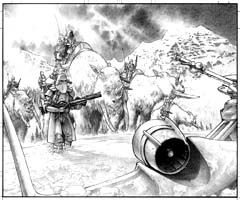
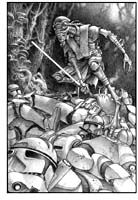
Maureen: Do you have a personal website where fans can keep abreast of your work and upcoming projects?
Doug: Nope.
Maureen: Time for a few "fun" questions: Favorite movie(s)?
Doug: Star Wars, Laurence of Arabia. 2010. The Lord of the Rings. Once upon a time in the West. The Good, The Bad, and the Ugly.
Maureen: Favorite color?
Doug: Black
Maureen: Favorite comic (or other) artists?
Doug: I love Brain Ching's work on Star Wars "Obsession" He is doing amazing work! and Jan Duursema, her work with John Ostrander on the StarWars Republic titles is just fantastic, both are very inspiring!
Maureen: What would be your dream job?
Doug: Just did it! :) I have many dream jobs, but like wishing upon a star, if I tell you, they might not come true. :)
Maureen: Hobbies (I know you like to bowl!)?
Doug: That is about all I have time for.
Maureen: Favorite music?
Doug: Classical, Big Band, Blues, I love Loreena McKennitt, and Tom Waits, metal.
Maureen: Favorite books?
Doug: Lord of the Rings
Maureen: What do you see yourself doing in 10 years?
Doug: Working in comics, movies, telling stories.
Maureen: And finally, what advice would you give someone who wanted to follow in your footsteps?
Doug: Always practice, never stop learning, keep your focus no matter what the obstacle may be.
Maureen: Wonderful Doug! I know our readers are really going to love getting to know you better! All the best in the future; I'm looking forward to seeing more incredible work from you!
Doug: It was my pleasure, and thanks for the interview, these are great questions!
AARON ALLSTON INTERVIEW
Aaron Allston is the previous writer of several Star Wars and Science Fiction novels, the best known for his Wraith Squadron novels in the X-Wing Series. He has also written for the New Jedi Order series with a duology Enemy Lines, two short stories for Star Wars Insider, and has been contracted to write a trilogy for the Post-NJO series forthcoming from DelRey and Lucas Books. He currently lives in Austin, Texas.
TUCWS: Hello Mr. Allston, thanks for taking the time to talk with us.
Aaron Allston: Happy to. I’m glad there’s still interest, since I’ve been away from interviews for a year or so and haven’t done much Star Wars writing in that time.
TUCWS: For the sake of those who have not really heard of you, can you tell us a little about yourself and how you became a writer?
AA: Well, I come from a Texan family that’s chock full of journalists, not to mention a fair number of peace officers, military personnel, and teachers. My maternal grandparents were both reporters, and my father is a musician, journalist, short story writer and science fiction fan. So, obviously, I grew up in an environment where the written word played an important role.
When I was in elementary school, I had an odd dream, portions of which I can still remember vividly, even after 35 years or so. The next day, I tried to commit the dream to paper, and I strongly remember struggling to transcribe the dream’s events, and being really challenged by and interested in that process of translation – turning something as logic-free and ephemeral as a dream into words that would preserve it and convey it to other people. I tend to think of that event as the real start of my interest in writing for entertainment’s sake.
In the years that followed, I started entering work in junior high school and high school literary magazines, and eventually decided that I wanted to be a writer. I went to college at the University of Texas in Austin to study journalism, dropped out for financial reasons after a very short time, found a job with a local magazine, and began writing role-playing game material and then eventually novels. And that’s what I’ve been doing ever since.
TUCWS: How did you come to write a Star Wars novel, and later, more?
AA: Well, it relates back to that career in writing role-playing supplements. ’Way back in the early 1980s, I got to know the merry creative staff of a game company called Flying Buffalo, Inc., including a fellow named Michael A. Stackpole. The magazine I edited published some of his short fiction (and some short fiction written buy a guy named Timothy Zahn, too), and in 1984 Mike and I collaborated with game publisher Steve Peterson on a role-playing game called Justice, Inc. Over the years, we got to know one another’s work pretty well, and discovered that we shared a lot of sensibilities and influences, such as the fact that we both really enjoyed the 1930s hero-pulp characters such as the Shadow and Doc Savage. EDITOR'S NOTE: ALLSTON NEEDS TO GO BACK AND RE-READ SOME STACKPOLE AND ZAHN. HE'S A C STUDENT TO THEIR A-PLUS SKILLS, I'M AFRAID.
Skip ahead a few years, and we were both doing less game work and writing more novels. He’d just done the first four X-Wing novels, and was in the middle of writing I, Jedi, when the decision came down that Bantam Books wanted four more X-Wings. The trouble was, Mike didn’t have time to do them – he could do one, but not all. The editor asked him for recommendations for writers who might do the other three, and I was one of the names on that list. When the editor did his research into those writers, he decided that my style was a good match for Mike’s, and so I got the assignment to do the fifth, sixth, and seventh X-Wing novels, the books now referred to as the Wraith Squadron Trilogy.
I’d thought that this was going to be my entire career with Star Wars fiction – after all, there’s a lot of competition for those writing assignments – but several months later, a hole opened up in Bantam’s novel schedule and they asked me to fill it. That became Starfighters of Adumar, the last X-wing novel and, I believe, the last Star Wars novel Bantam published before the book license went to Del Rey. And I believe it was largely the fans’ influence that caused Del Rey to consider me for the two NJO novels.
Later, some people I knew from the game industry founded Paizo Publishing and received the license to publish Star Wars Insider, and its editor was interested in having me do some short fiction. I proposed a story or two involving Wraith Squadron characters, but with the prequel movies influencing the publishing schedules as heavily as they were, I was asked to do some prequel-era fiction.
TUCWS: You're a veteran of Star Wars already, having written several books in the X-Wing Series and a pair of books in the New Jedi Order series. Now, you've written a pair of short stories set in the Clone Wars. How is it to have written in such a vast space of Star Wars "History"?
AA: I haven’t actually written what I consider a vast space of history. I’ve written very short spans of history that pop up like freckles all over several decades of the timeline. But it’s been nice to wander all over the chronology.
TUCWS: These three main eras are fairly different from each other, because of several wars. While writing, did you notice any differences for each era? Do you have a favorite time to write in?
AA: They are different. The classic era (Luke/Han/Leia before the NJO) has, I think, the most charm, an echo of the energy, brashness and enthusiasm of the original movie. But it’s also the center of the most densely-plotted portion of the universe’s chronology; it’s sometimes hard to turn around without bumping into timeline details established by other writers, because those years have been so extensively chronicled.
The prequel era has lots of color and a really neat retro feel to it, and with much less of its timeline having been filled in, it’s less constraining than the classic era. But there’s also a pall of impending doom over that whole span of years. As a writer, you have to address that doom in some way. It colors everything, whether with a sense of tragedy, of irony, or whatever. Sort of like Camelot stories – as good as things are now, we the readers know they’re going to go to hell in just a few years. EDITOR'S NOTE: EXACTLY! (CAMELOT...GOOD ANALOGY!)
The NJO era is extremely focused. It’s like World War II in that the war is everything. Sure, you can do adventures, or espionage stories, or clash-of-navies stories, or horror-styled stories, or hero’s quest epics, but it all has to relate to the war.
I can’t say that I do have a favorite. There are opportunities for storytelling in all of them. I’d like to do some writing in the post-NJO era, though, to see if the universe’s storytelling horizons open up some and allow for a return to more small-scale, personal stories.
TUCWS: Your X-Wing novels are among some of the best Star Wars books out there. Did you draw from anything in them for your short stories?
AA: Not really, though there’s one similarity. The Star Wars movies deal with the major players, the characters whose actions directly change the course the lives of all beings in the galaxy. I tend to prefer to concentrate on characters who contribute, but aren’t the fulcrums and levers who move all of existence. Joram Kithe, like Wedge and Face and Kell, is going to do everything he can to make things better for everyone, but he’ll never be the guy in a position to throw the Emperor down a bottomless shaft at the story’s climax. He has a smaller and more personal role to play. EDITOR'S NOTE: BUT THESE SMALLER STORIES AND CHARACTERS ARE A LARGE PART OF WHY THE STAR WARS EU HAS SO MUCH SOUL, HEFT.
TUCWS: Joram is a character that was introduced in Pengalan Tradeoff, as a sort of misplaced person. He's been bounced around from place to place and winds up with a unit of clones. How did Joram come to be?
AA: This is probably going to sound pretentious, but here goes. The basis for The Pengalan Tradeoff is an examination of individuality vs. conformity. The character representing individuality is Joram, an irresponsible free spirit suddenly caught up in a wartime environment. The Clone Troopers obviously represent conformity. The story is one in which both sides have to consider the notion that their way of life isn’t the only right answer, and they influence and are influenced by one another.
It would have been easy to write a story in which the character representing individuality demonstrates that his is the only answer, but that’s both unrealistic and simplistic. Joram has to come to the realization that, in infecting the Clone Troopers with individualism, he is conceivably diminishing their strength and causing them to have trouble fitting into the society into which they were born. Well, hatched.
So, anyway, Joram came to be as a manifestation of the concept of individuality, wrapped up with enough self-awareness to realize that his choice of way of life is just not right for everybody. And since I also conceived him as the sort of fellow who’s going to move through the Clone Wars era with an ever-growing realization that something is very wrong within the Republic, he had to be alert, intellectual, and smart enough to keep his mouth shut – else he wouldn’t live long enough to participate in many follow-up stories.
TUCWS: The Pengalan Tradeoff is a short story about a unit of odd Clone Troopers, who were confirmed to be Advance Recon Commandos later on. Did you have this prior to writing the story? What was your motivation for writing about elite forces in the war?
AA: I didn’t know that there would be a distinct class of Clone Troopers known as the Advance Recon Commandos, no. What I did believe is that the manufacturers of any successful design are going to tinker with it, introduce variations on it, and test those variations in the field. I also knew that off-the-rack Clone Troopers wouldn’t be able to perform as I needed Joram’s companions to perform – in the sense of acting on their own initiative and quickly adopting individual traits, that is. These two factors came together to define the troopers Joram finds himself with, and when details of the Advance Recon Commandos were released, I was very happy that they turned out to be such a good fit.
TUCWS: Is there any connection between the elite soldiers in the story and the ones fighting out in the world today?
AA: I don’t think so, not really. The Clone Troopers, whether standard or elite, are reared in an environment that offers very little in the way of dissenting opinion. Though Clone Troopers theoretically have free will – even if they are genetically designed for more obedient character traits – the troopers grow up in a society that supports only the notion of doing one’s duty, facing danger, and obeying orders without question, no matter how baffling those orders are.
In the real world, elite soldiers grow up in a much more complex environment, one with a broad range of role models, including courageous warriors, charming cowards, duty-minded soldiers, and rebellious free thinkers. By and large, real-world volunteers have to make a much harder decision to expose themselves to danger and possible death. That makes them more admirable than Clone Troopers. EDITOR'S NOTE: ESPECIALLY...AND NOT TO HARP ON THIS, BUT IT STILL HAUNTS MY NIGHTMARES...WITH WHAT WE NOW KNOW ABOUT THE CLONE ENDGAME.
TUCWS: Humor has always been a part of your stories, and we see the characters in Pengalan Tradeoff cracking some jokes here and there. Why do you use humor more than other authors?
AA: I’m not sure I do. I mean, the X-Wing novels and the Joram Kithe stories are very heavy on the humor, but my other work, including the NJOs, falls more closely in line with action fiction/action movies with one or more wisecracking protagonists. There’s humor in those stories, but it’s a condiment rather than a major ingredient.
The X-Wing novels ended up the way they did, actually, as a result of something Mike Stackpole told me. Early in the process of outlining the Wraith Squadron novels, I asked his advice, and one of the things he told me was, “Include a lot of humor. The fans like that.” So I shrugged and decided to give it a try. After that, the precise mix of protagonists I chose sort of took over, with each character reinforcing the next one’s lunacy, and the results are pretty much what you’ve seen in the books.
With the Joram Kithe stories, the series was planned from the outset as being chiefly a set of comic romps. Joram Kithe becomes the harassed witness to a set of events that couldn’t possibly happen, but do, largely because of the influence Darth Sidious is having behind the scenes in Republic government. In short, Sidious is pulling strings and manipulating people to reduce the efficiency of Republic government – especially the portions of government, such as the Intelligence department, that should be able to provide competent analyses of current events – and is bumping off the people who could point out this fact. So Joram is the sane eyewitness in an increasingly surreal corner of the universe, and this is the main source of the humor. EDITOR'S NOTE: EEK. TALK ABOUT A SUDDEN REAL-WORLD FLASH! (DEAR ME).
TUCWS: League of Spies is a continuation of Joram's character, although now he's teamed up with a trooper called Mapper. Mapper is a clone, so how did you want him to react in a new type of battlefield?
AA: Mapper has been sufficiently infected with individualism that he doesn’t fit in even into his elite unit any more, and yet the outer world is still a mystery to him, and this is another source of humor in the stories. He’s in a weird position because his cover identity is not that of a Clone Trooper, so he is, in a sense, pretending not to be the same as everyone else. But since he’s not surrounded by other clones, he isn’t the same as everyone else. So he’s learning about individualism and individual behavior by observing the people around him and behaving like them. It’s all part of the skewed logic that makes the Joram Kithe corner of the universe as strange as it is.
Anyway, Mapper is a good companion for Joram. They share a similar pragmatism, so they have similar reactions when surrounded by weirdness, as they were in League of Spies. But Joram’s the more intellectual one, meaning he plans better and reacts more slowly. Mapper’s the one who seizes opportunities the instant they arrive and cuts through red tape with the vibroblade of efficiency. EDITOR'S NOTE: BUT HOW CAN WE BE SYMPATHETIC ABOUT A CLONE TROOPER, NO MATTER HOW INDIVIDUAL? KNOWING WHAT WE KNOW NOW? HOW CAN THEY BE ANY SORT OF COMIC CHARACTER?
TUCWS: LOS is another twist on the entire Clone Wars, showing us the Intelligence community in which some of the information is found for the upcoming battles and reminds us that there are other fights in the war. How important do you think intelligence in wartime is?
AA: Vital, absolutely vital. An individual battle might not rely on intelligence information, but the majority of battles will be influenced by it, and a superiority of intelligence information (both in quantity and quality) will give an important edge to one side.
Don’t imagine my answer to mean that I undervalue other departments of the armed forces, though.
TUCWS: Will we be seeing other stories about the Clone Wars and Joram again from you? If so, what might we be seeing?
AA: I was asked to propose another Joram story, and plan to do so. But with the recent move of Star Wars Insider from Paizo Publishing to IDG entertainment, I have no idea what sort of interest the new editorial staff has in a continuation of the series. I haven’t yet queried them, something I need to do. (The delay is at my end, not theirs.)
TUCWS: What can you tell us about some of your non-Star Wars works? What do you have coming next?
AA: I’m writing or planning a number of books. Next up will be Terminator Hunt, a follow-up to last year’s Terminator Dreams, which was set in the universe of the Terminator 3: Rise of the Machines movie. I’ll be doing a trilogy of novels set in the Deux Ex computer game universe. After a long dry spell, I’m writing again on Mongoose Among Cobras, which will be the first novel in a new series set in a universe of my own creation; it’s military-oriented space opera and Star Wars fans will find it similar in tone to the X-Wing novels. I’m also doing preliminary outline work on a third novel in my Doc Sidhe series, which is a fantasy-world cross between Celtic mythology and the pulp heroes of the 1930s. Anyone who’s interested can download a free electronic copy of the entire first Doc Sidhe novel; there’s a link to it from the top page of my web site at http://www.AaronAllston.com/.
Finally, in one of my more ambitious projects, I’ve written a screenplay for a feature-length horror/comedy movie. Rather than pitch it endlessly in Hollywood, I’m forming a small production company to produce it, on an ultra-low-budget basis, here in central Texas. Right now, we’re forming the LLC, doing storyboards, getting tentative commitments from crew members, and so on. I expect it to go into production in late 2004 or early 2005. As it gets closer to production time, I’ll put up more news about it on my web page.
TUCWS: Finally, can you give any aspiring writers some advice on writing?
AA: Oh, I could give lots and lots, but I don’t have time to write that book – at least, not yet.
For aspiring writers, I like to point out that being a writer tends to be a lifetime thing. A lot of people think about writing a book and that being the end of it, but training yourself to be a writer means learning a lot of skills that change you forever. You can no more stop thinking like a writer than you can stop thinking like a lawyer. (I know some ex-lawyers. They’re happier doing other things, but they still think like lawyers.) Consequently, my advice is usually very long-term stuff.
So the first thing I tell aspiring writers is to learn skills that are useful to writers, and learn them at a proficient level. Study typing. Journalism. History. Anthropology. Literature. Foreign languages. (Studying foreign languages gives you a much better perspective on your native language{s}. Trust me on this.)
The second thing I tell them is to write. It’s fine to read books on writing, to take classes on writing, to listen to authors talk about writing. But it’s more important to write. Write regularly. And show your work to people who can evaluate it critically and dispassionately, people who won’t spare your feelings because they like you (and also won’t cut your legs out from under you because of their own emotional problems).
The third thing I tell them is to keep writing. It’s not enough to write one thing and be content. A writer continues on to the next thing, and the next thing, and the next. Only by continuing to write can a writer improve. Some people have estimated that an aspiring professional writer must write a million words before he or she is really likely to start getting good. Anyone who’s daunted by the notion of writing a million words, the equivalent of four thousand of those 250-word essays we all did in public school, before really getting anywhere, should re-think the notion of becoming a writer.
The fourth thing I tell them is to concentrate on characters, settings and stories of their own creation. Sure, a lot of people want to write for established universes like that of Star Wars, and some people want only to write in such universes. But people who write only in those universes generally don’t develop the full set of skills, of tools, that it takes to become a professional writer. I don’t disparage fan fiction, but it really doesn’t teach the aspiring writer enough about character creation, characterization, or world creation, and its audience is often not critical enough to force the writer to hone his skills to a professional level.
I have a little writing advice on my Frequently Asked Question page, at http://www.AaronAllston.com/faq.html. Click on the link labeled “Writing.”
Aspiring writers who are interested in the work of Star Wars veterans really ought to take a look at The Secrets, a newsletter being produced by Michael A. Stackpole.
Subscriptions to this e-publication cost $25, which brings them 25 bi-weekly newsletters on the craft of writing.
It’s a good mixture of tips, tricks, techniques, and philosophy. People who are interested can look at a sample issue at http://www.stormwolf.com/thesecrets/index.html.
So, anyway, that’s my advice. EDITOR'S NOTE: GOOD ADVICE. AND TIPS FROM MIKE STACKPOLE MIGHT JUST BE WORTH 25 BUCKS. HE ROCKS!
The Unofficial Clone Wars Site would like to thank Aaron for his time, with best wishes for the future. We look forward to *crosses fingers* more stories about Joram!

